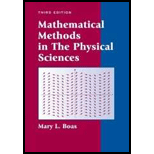Problem 1P: 1 to 21. Use the Cauchy-Riemann conditions to find out whether the functions in Problems 1.1 to 1.21... Problem 2P: 1 to 21. Use the Cauchy-Riemann conditions to find out whether the functions in Problems 1.1 to 1.21... Problem 3P: 1 to 21. Use the Cauchy-Riemann conditions to find out whether the functions in Problems 1.1 to 1.21... Problem 4P: 1 to 21. Use the Cauchy-Riemann conditions to find out whether the functions in Problems 1.1 to 1.21... Problem 5P: 1 to 21. Use the Cauchy-Riemann conditions to find out whether the functions in Problems 1.1 to 1.21... Problem 6P: 1 to 21. Use the Cauchy-Riemann conditions to find out whether the functions in Problems 1.1 to 1.21... Problem 7P: 1 to 21. Use the Cauchy-Riemann conditions to find out whether the functions in Problems 1.1 to 1.21... Problem 8P: 1 to 21 . Use the Cauchy-Riemann conditions to find out whether the functions in Problems 1.1 to... Problem 9P: 1 to 21. Use the Cauchy-Riemann conditions to find out whether the functions in Problems 1.1 to 1.21... Problem 10P: 1 to 21. Use the Cauchy-Riemann conditions to find out whether the functions in Problems 1.1 to 1.21... Problem 11P: 1 to 21. Use the Cauchy-Riemann conditions to find out whether the functions in Problems 1.1 to 1.21... Problem 12P: 1 to 21. Use the Cauchy-Riemann conditions to find out whether the functions in Problems 1.1 to 1.21... Problem 13P: 1 to 21. Use the Cauchy-Riemann conditions to find out whether the functions in Problems 1.1 to 1.21... Problem 14P: 1 to 21. Use the Cauchy-Riemann conditions to find out whether the functions in Problems 1.1 to 1.21... Problem 15P: 1 to 21. Use the Cauchy-Riemann conditions to find out whether the functions in Problems 1.1 to 1.21... Problem 16P: 1 to 21. Use the Cauchy-Riemann conditions to find out whether the functions in Problems 1.1 to 1.21... Problem 17P: 1 to 21. Use the Cauchy-Riemann conditions to find out whether the functions in Problems 1.1 to 1.21... Problem 18P: 1 to 21. Use the Cauchy-Riemann conditions to find out whether the functions in Problems 1.1 to 1.21... Problem 19P: 1 to 21. Use the Cauchy-Riemann conditions to find out whether the functions in Problems 1.1 to 1.21... Problem 20P: 1 to 21. Use the Cauchy-Riemann conditions to find out whether the functions in Problems 1.1 to 1.21... Problem 21P: 1 to 21. Use the Cauchy-Riemann conditions to find out whether the functions in Problems 1.1 to 1.21... Problem 22P: 1 to 21. Use the Cauchy-Riemann conditions to find out whether the functions in Problems 1.1 to 1.21... Problem 23P: 1 to 21. Use the Cauchy-Riemann conditions to find out whether the functions in Problems 1.1 to 1.21... Problem 24P: 1 to 21. Use the Cauchy-Riemann conditions to find out whether the functions in Problems 1.1 to 1.21... Problem 25P: Using the definition (2.1) of (d/dz)f(z), show that the following familiar formulas hold. Hint: Use... Problem 26P: Using the definition (2.1) of (d/dz)f(z), show that the following familiar formulas hold. Hint: Use... Problem 27P Problem 28P: Using the definition (2.1) of (d/dz)f(z), show that the following familiar formulas hold. Hint: Use... Problem 29P: Problem 28 is the chain rule for the derivative of a function of a function. Hint: Assume that df/dg... Problem 30P: Problem 28 is the chain rule for the derivative of a function of a function. Hint: Assume that df/dg... Problem 31P: Problem 28 is the chain rule for the derivative of a function of a function. Hint: Assume that df/dg... Problem 32P: Using the definition of ez by its power series [(8.1)ofChapter2], and the theorem (Chapters 1 and 2... Problem 33P: Using the definitions of sin zandcosz[Chapter2,equation(11.4)], find their derivatives. Then using... Problem 34P: Using series you know from Chapter 1, write the power series (about the origin) of the following... Problem 35P: Using series you know from Chapter 1, write the power series (about the origin) of the following... Problem 36P: Using series you know from Chapter 1, write the power series (about the origin) of the following... Problem 37P: Using series you know from Chapter 1, write the power series (about the origin) of the following... Problem 38P: Using series you know from Chapter 1, write the power series (about the origin) of the following... Problem 39P: Using series you know from Chapter 1, write the power series (about the origin) of the following... Problem 40P: Using series you know from Chapter 1, write the power series (about the origin) of the following... Problem 41P: Using series you know from Chapter 1, write the power series (about the origin) of the following... Problem 42P: Using series you know from Chapter 1, write the power series (about the origin) of the following... Problem 43P: In Chapter 12, equations (5.1) and (5.2), we expanded the function (x,h) in a series of powers of h.... Problem 44P Problem 45P Problem 46P Problem 47P Problem 48P: Using polar coordinates (Problem 46), find out whether the following functions satisfy the... Problem 49P Problem 50P: Using polar coordinates (Problem 46), find out whether the following functions satisfy the... Problem 51P Problem 52P Problem 53P: Using polar coordinates (Problem 46), find out whether the following functions satisfy the... Problem 54P: Show that the following functions are harmonic, that is, that they satisfy Laplaces equation, and... Problem 55P: Show that the following functions are harmonic, that is, that they satisfy Laplaces equation, and... Problem 56P: Show that the following functions are harmonic, that is, that they satisfy Laplaces equation, and... Problem 57P: Show that the following functions are harmonic, that is, that they satisfy Laplaces equation, and... Problem 58P: Show that the following functions are harmonic, that is, that they satisfy Laplaces equation, and... Problem 59P: Show that the following functions are harmonic, that is, that they satisfy Laplaces equation, and... Problem 60P: Show that the following functions are harmonic, that is, that they satisfy Laplaces equation, and... Problem 61P: Show that the following functions are harmonic, that is, that they satisfy Laplaces equation, and... Problem 62P: Show that the following functions are harmonic, that is, that they satisfy Laplaces equation, and... Problem 63P: Show that the following functions are harmonic, that is, that they satisfy Laplaces equation, and... Problem 64P: It can be shown that, if u(x,y) is a harmonic function which is defined at z0= x0+iy0, then an... format_list_bulleted


 Mathematics For Machine TechnologyAdvanced MathISBN:9781337798310Author:Peterson, John.Publisher:Cengage Learning,Algebra & Trigonometry with Analytic GeometryAlgebraISBN:9781133382119Author:SwokowskiPublisher:Cengage
Mathematics For Machine TechnologyAdvanced MathISBN:9781337798310Author:Peterson, John.Publisher:Cengage Learning,Algebra & Trigonometry with Analytic GeometryAlgebraISBN:9781133382119Author:SwokowskiPublisher:Cengage Elements Of Modern AlgebraAlgebraISBN:9781285463230Author:Gilbert, Linda, JimmiePublisher:Cengage Learning,
Elements Of Modern AlgebraAlgebraISBN:9781285463230Author:Gilbert, Linda, JimmiePublisher:Cengage Learning, Linear Algebra: A Modern IntroductionAlgebraISBN:9781285463247Author:David PoolePublisher:Cengage Learning
Linear Algebra: A Modern IntroductionAlgebraISBN:9781285463247Author:David PoolePublisher:Cengage Learning


